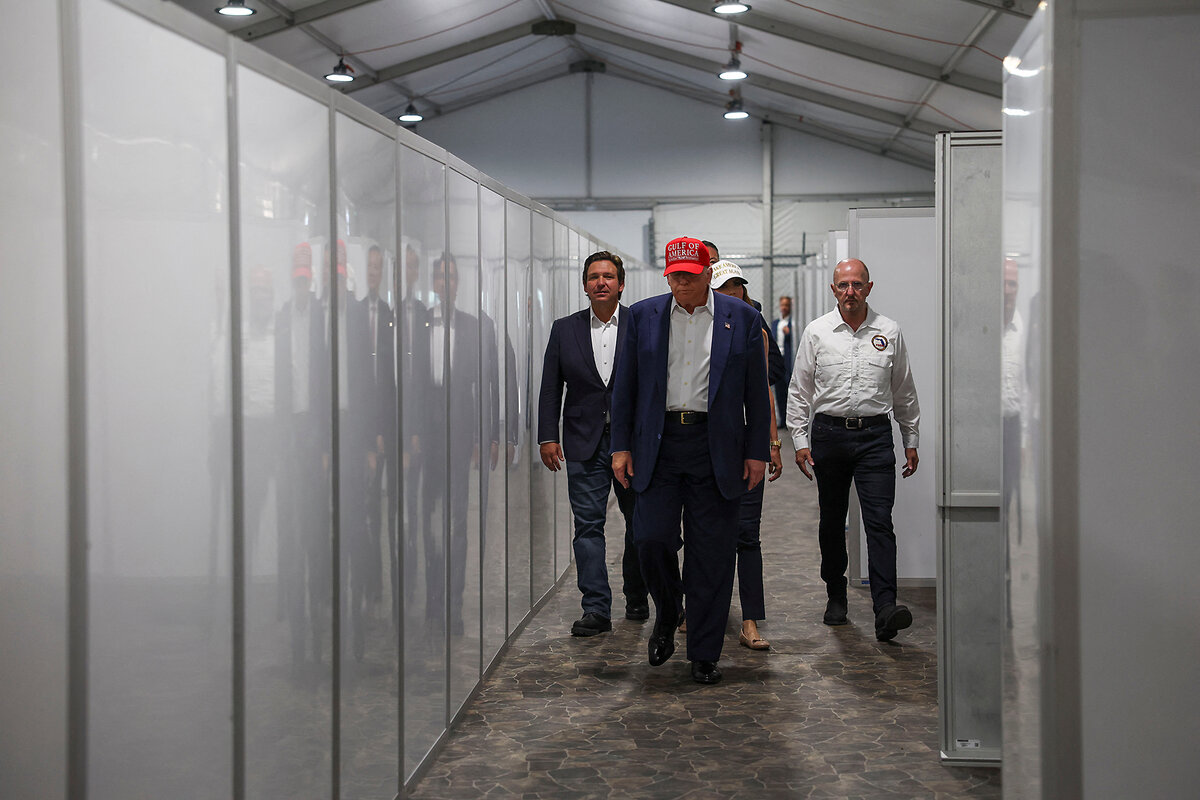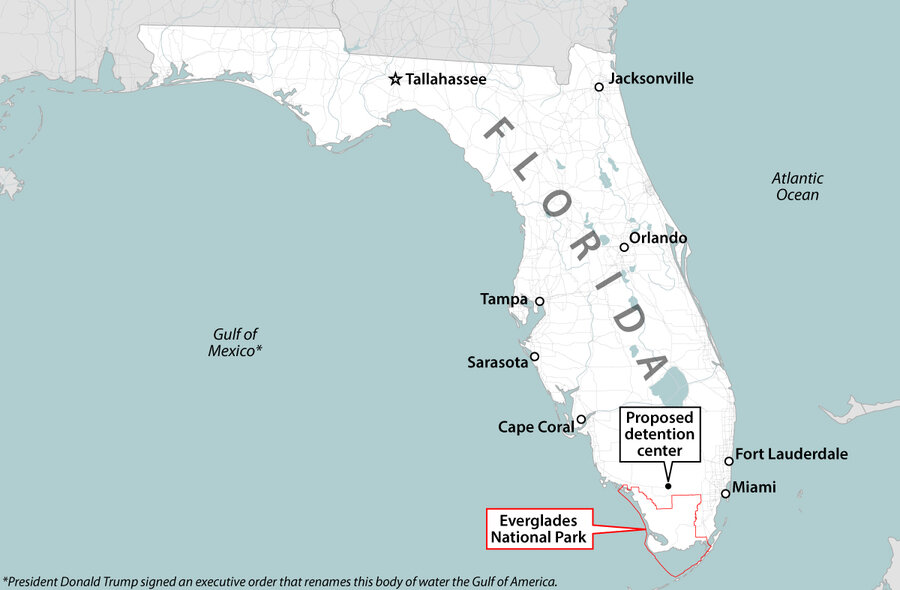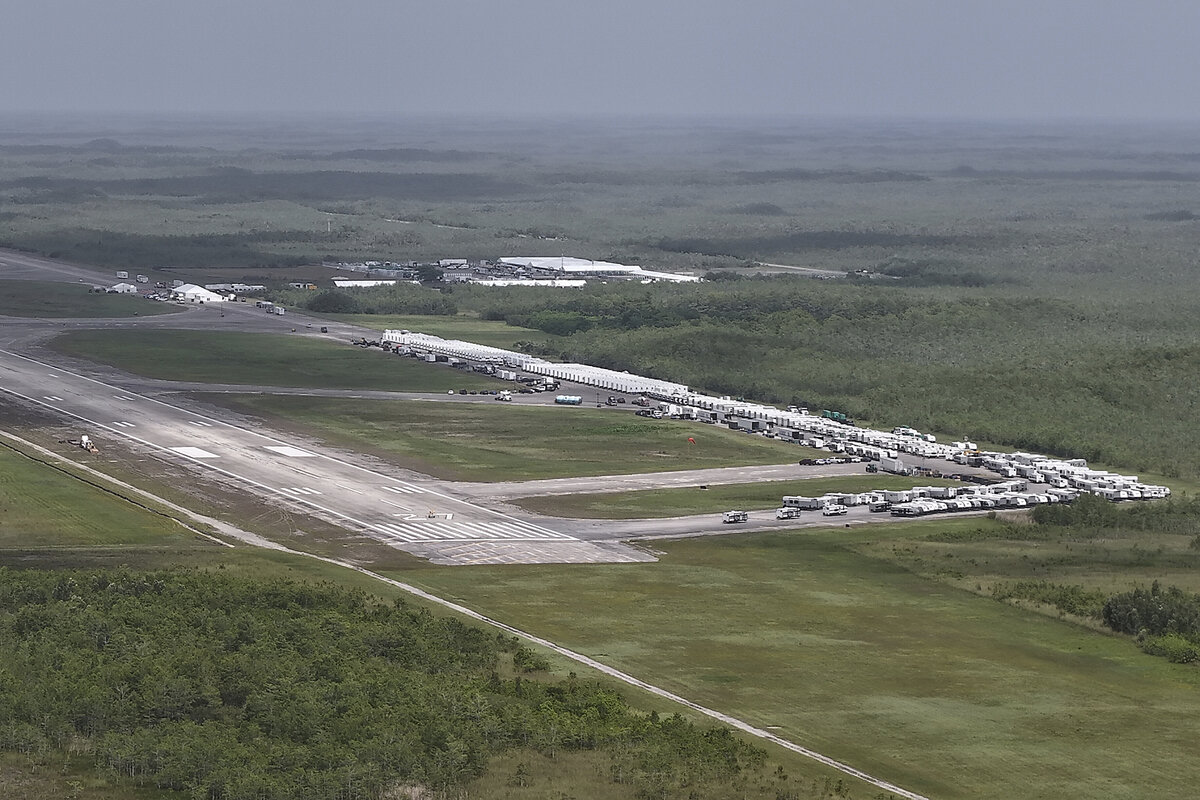As ‘Alligator Alcatraz’ opens, detention centers quietly expand across the US
Loading...
President Donald Trump made a visit Tuesday to mark the opening of a controversial immigrant detention site in Florida that officials have dubbed “Alligator Alcatraz,” underscoring the administration’s commitment to expanding its mass deportation campaign through a variety of partnerships.
“This facility is exactly what I want every single governor in this country to consider doing with us,” said Homeland Security Secretary Kristi Noem, in Florida with the president on Tuesday.
The Alligator Alcatraz site is one of an array of unorthodox ways in which the Trump administration and supportive states are looking to square a rise in the number of immigrants arrested with limited space to hold people while they await court proceedings or deportation. The effort raises questions about how many new detention facilities are being built across the United States and what the long-term effect of such projects will be.
Why We Wrote This
President Donald Trump is touting Florida’s unusual new immigration detention facility in the Everglades – part of a wider effort underway to create spaces to hold people caught up in the administration’s deportation campaign.
The Trump administration has set an aggressive target of arresting 3,000 unauthorized immigrants a day, and the Department of Homeland Security (DHS) has of 1 million deportations per year. As a result, Immigration and Customs Enforcement (ICE) has needed to rapidly expand detention capabilities, including by increasing partnerships with state governments and private prison companies.
What is Alligator Alcatraz?
Florida Attorney General James Uthmeier proposed the idea for the detention center in a June 19 , nodding to the famous Alcatraz prison near San Francisco, now a museum. The Florida detention center is based at an old airport facility, and the site is bordered by the waters of the Everglades, which are home to alligators and pythons.
Mr. Uthmeier called the plan an “efficient, low-cost opportunity to build a temporary detention facility,” and said he received approval for the plan from the DHS. Florida is pursuing a hard-line immigration enforcement campaign in support of President Trump’s agenda.
Florida Gov. Ron DeSantis authorized the construction under emergency powers. The state quickly built up the site using heavy-duty tents and trailers. Secretary Noem said the site, which will be managed by the state of Florida, will have around 3,000 beds, with 2,000 at another location.
In February, Governor DeSantis directed state law enforcement to enter into new agreements with ICE allowing Florida officers to perform specific immigration functions, like detaining individuals until ICE can take custody.
DHS says the site will cost Florida about $450 million for one year, and that the state can submit reimbursement requests to the Federal Emergency Management Agency.
Protesters lined streets outside a virtually abandoned airstrip in Florida June 28 to oppose the official opening. Many cited environmental concerns and potentially poor conditions for the immigrants held there. The Miccosukee and Seminole tribes also consider the land sacred. Florida Rep. Maxwell Frost, a Democrat, called the facility a “cruel spectacle” intended to “brutalize, starve, and harm immigrants.” Environmentalists to stop the plan.
How is ICE expanding detention centers to meet deportation goals?
Congress has currently allocated funding for over detention beds, according to the American Immigration Council. The tax and spending bill Republicans in Congress are scrambling to pass by July 4 could increase ICE’s annual detention spending by billions, and is expected to significantly expand its detention capacity.
ICE has legal authority to detain people who either are in removal proceedings or face removal orders. Detention requirements were expanded under the Laken Riley Act, passed earlier this year, requiring officers to detain individuals arrested for certain crimes even if they’re not yet convicted.
Options for detention include partnering with state and local governments. ICE is also expanding no-bid contracts with private prison companies to free up more detention space. In places like Burlington, Massachusetts, a number of detainees have been held for days at a time in an ICE field office that’s normally used for administrative work, according to local news reports. ICE did not respond to requests for clarification.
Ira Mehlman, media director at the conservative Federation for American Immigration Reform, supports the role of detention facilities. “If you’re going to have any meaningful way of actually executing [deportation] orders, then you have to keep people detained, so you’re sure that they can be removed,” he says.
What are the conditions like at these centers?
The spike in ICE arrests has led to widespread complaints of overcrowding in detention centers, including allegations of unsanitary and sometimes unsafe conditions. In Burlington, lawyers told their clients lacked access to showers and sufficient food.
DHS says claims of overcrowding in ICE facilities , and that ICE has higher quality standards for its facilities than most U.S. detention spaces.
Conditions for detained immigrants have always been bad, says Eunice Cho, a senior staff attorney at the American Civil Liberties Union National Prison Project. But she says they’ve gotten worse under the second Trump administration.
“Immigrants are in civil detention; they are not serving time for criminal offenses,” says Ms. Cho. “Placing them in prisons is basically subjecting people to unconstitutional punishment.”
As of June 15, there were 56,397 individuals in ICE detention – the most since a previous high during the first Trump term, Austin Kocher, a researcher at Syracuse University. Just over half – 54% of those detainees – had criminal convictions or pending criminal charges. The rest were immigration violators who did not have criminal convictions or charges known to ICE, according to the agency.
What kind of oversight do detention centers have?
Each ICE detention center is governed by internal standards that encompass food service, medical care, and the availability of legal materials.
ICE conducts internal inspections of its detention facilities, which are usually preannounced. The DHS inspector general also conducts unannounced visits. Others who can conduct inspections include the Government Accountability Office and members of Congress.
Congressional oversight was put in the spotlight in May, when a confrontation broke out as a group of Democratic officials tried to inspect a recently reopened ICE detention center in Newark, New Jersey.
Newark Mayor Ras Baraka was asked by federal officials to leave after he had entered through the gate. Federal agents then arrested him. The New Jersey U.S. Attorney’s Office dropped the charges 10 days later.
A federal grand jury subsequently indicted New Jersey Rep. LaMonica McIver, who was also at the facility, on criminal charges for allegedly striking federal officials at the scene. Representative McIver has called the proceedings “political intimidation.”
Legally, members of Congress are authorized to conduct oversight of any ICE facility used to detain migrants without providing “prior notice of the intent to enter.”
“It’s enormously important to be able to provide short-notice visits to facilities to be able to capture the actual human rights violations that are occurring,” says Holly Cooper, co-director of the Immigration Law Clinic at the University of California, Davis School of Law. “Because with notice comes cleanup, comes transferring of people.”
How does ICE work with the private sector to detain migrants?
As of January 2025, were held in facilities run by for-profit entities. The two major players in private immigration detention are private prison companies, The Geo Group and CoreCivic.
Both have signed new detention facility contracts with ICE since Mr. Trump’s inauguration. And stock prices for each in the days after Mr. Trump was elected.
Government cooperation with private prison companies isn’t new – tens of thousands of immigrants were held in private detention centers under both the Obama and Biden administrations, although both also pursued policies to phase out contracts with private prisons.







